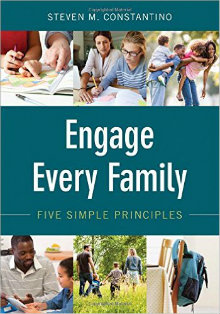5 Simple Principles Can Help Engage Families
Engage Every Family: Five Simple Principles
By Steven M. Constantino
(Corwin, 2016 – Learn more)

Families. Such an integral part of a student’s progress in learning. So many times in my four decades of being a teacher I have had students and parents return to tell me joyfully about successes.
Each year I set a goal of making sure that all the families of my students feel connected to the school and know that they are part of a team. Yet it seems that this goal always gets lost in the myriad of lessons, meetings, initiatives, and movements of my life – and I end up reaching just a few families.

What you’ll learn in the book
The book is set up so that a team can reflect on what is currently happening in their school with families, delve into the five principles, and then work towards including everyone.
Constantino makes it clear that this is a slow process and stresses that this is not just another initiative or something more to do but, instead, a way to make what we now do even better.
Throughout the book there are spaces (with calm blue backgrounds so they are easily found) where the reader can write responses to prompts and questions. Several very realistic and revealing scenarios, or case studies, are given to aid the reader’s thinking process about what he/she values and believes about relationships with all parents.
All of the charts, surveys, forms, and ideas are also provided online at the author’s website.
Dr. Constantino has worked at all levels of education and currently serves with the Virginia Department of Education. He has done many workshops and presentations around the world. (His family engagement speech for the PTA is on YouTube). He believes in continuous improvement and that new ideas need to be tried, measured, and then implemented if they show that they work.
This book provides a way to do just that.
For those who like the big picture first, Constantino uses the first four chapters to give an overview of the five principles and how to use the book. He states that the principles build upon one another and are most effective done in order. The next five chapters explain each principle in depth.
Principle #1 – A Culture That Engages Every Family
To begin, there must be a culture within all of the school that invites all families to be a part of the improvement of student learning. This culture is framed by a welcoming mindset and depends upon the values of the staff and an accessible physical environment.
Principle #2 – Communicate Effectively and Build Relationships
This chapter is the longest and the most useful one for classroom teachers in that it gives several ideas on how to help all families (even the reluctant, no-show ones) feel that they are a welcomed part of their child’s education.
Principle #3 – Empower Every Family
Now that the relationships are built, teachers can help parents help their children with the ideas, skills, and strategies that are being studied at school. Again this is work done in each classroom.
Principle #4 – Engage Every Family in Decision Making
Work is now expanded to the school (or district). Families are included on teams or committees that make policy.
Principle #5 – Engage the Greater Community
Now the work of getting people engaged expands to the businesses and organizations in the community that can help in all areas of a student’s education (health, character, career, etc.).
The ideas can be adapted by teachers
Although the author imagines these concepts will be used by a school or, better yet, a district, I believe that if a single teacher wanted to improve family engagement in her/his own classroom, the ideas included in the first three principles would be helpful.
Because this book is not set up as a list of ideas, it would require slow reading (and time) to find the pages that are useful to an individual and to ferret out the several tangible suggestions of ways to engage with and communicate to families.
Constantino states that this process will not add to a teacher’s load; however there are some suggestions that I felt would indeed take extra time. The reward down the road would be beneficial though.
On the final pages Constantino emphasizes that in this time, when educators are often overwhelmed by the array of ideas, strategies, and initiatives to improve or reform education, engaging every family is not optional.
“Empowering the first and most influential teachers of children” is a notion that cannot “be relegated to the end of the list.”
Nestled in the woods in a corner of the state of Washington is Kendall Elementary where, for the past 25 years, Cindy Purdy has been teaching literacy to fifth and sixth graders. Before that she taught in the states of Idaho, Arizona, and Oregon. A lifelong learner, she has a never-ending thirst for ideas that stimulate her to improve her craft.



































